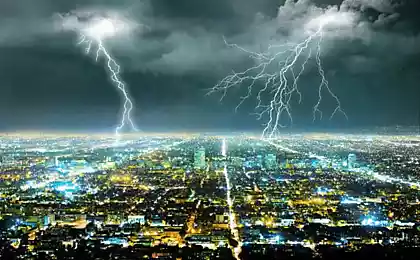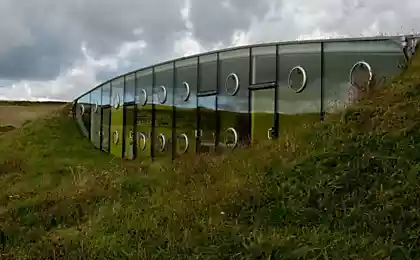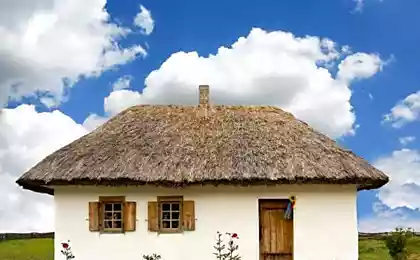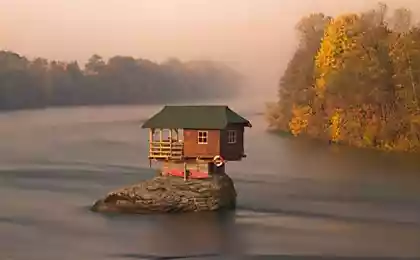666
How to protect your house from being struck by lightning
Lightning protection prevents lightning strikes a house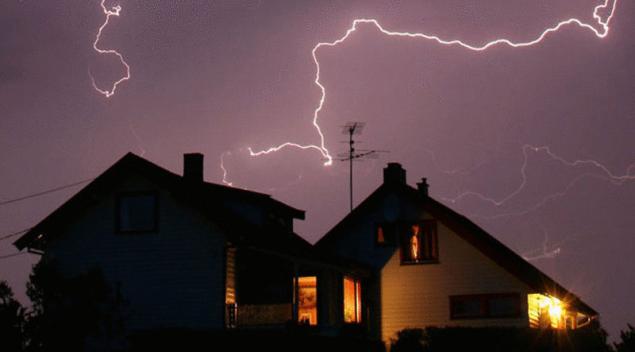
Getting to the construction of a country house, you should think about how to protect your home from possible electric shock from lightning.
The scale of destruction of a residential building in the event of being hit by a lightning discharge can be so large that the issues of lightning protection should be approached very seriously. The power projects of private houses with their commissioning does not require the presence of lightning protection systems. The decision on whether the installation of such systems usually takes the owner of a country estate.

Fig. 1. A comprehensive lightning protection system of a private house looks like this
At the stage of design and construction of a country house should provide for the establishment of molniezaschita circuit (discharger or, in common parlance, the lightning rod). The principle of the lightning rod is to protect the house from possible destruction by discharge of the electric discharge in the earth.The installation of lightning protection system is recommended at the beginning of construction, and more specifically, during installation of the roof because in this case less costs, also remains the integrity of the roofing.
Home lightning protection will be effective only with the integrated use of external and internal protection systems. External (exterior) lightning protection system provides safety at home in case of direct lightning.
There are two methods external lightning protection. This is a traditional pin-lightning rod (lightning rod Franklin) and the second using the system pin (Faraday cage). The difference of both methods slightly: the first method is used in the lightning protection of relatively small houses and cottages, the second — for the protection of large objects. As for the unit system of lightning rod, for all types of lightning protection is the lightning, the collector and the circuit ground.
The purpose of each element of this system are as follows: lightning captures lightning, and the collector or the descent passes the lightning from the lightning to the earth, which, in turn, extinguishes the lightning in the ground.
The discharge of lightning takes on the lightning. It is a metallic conductor with a length of at least 1.5 meters. This conductor is also called pin lightning: it is a metal rod of any cross-sectional shape (round, square, rectangular) length not less than 0.25 meters. The minimum size of the cross section is 12 mm. Metal rod or pin is made of copper or galvanized steel, materials not susceptible to oxidation (metal lightning staining is not subject).
Since lightning takes the brunt of lightning that must withstand high thermal and dynamic loads. Set on a high pole fixed to the roof ridge. Such a method of installation of lightning is used strictly for metal roofs. On the roof of slate lightning is arranged differently. The wire is pulled along the roof ridge of the roof. One end of the metal conductor is welded to the lightning, the other is lowered into the ground along the wall of the house.

Fig. 2. Traditional external lightning protection system at home
If the roof is made of shingles, then along the ridge along the entire length of the roof stretched molniezaschita steel mesh. The mesh is attached to electrodes which, in turn, are connected with lightning and earthing circuit. Most often, a grid is placed on the stage of construction of the house. Collector. Its purpose, as we remember, is adopted to guide the electrical discharge into the ground. The collector always is laid on the wall opposite to the one which is the front door. The wire, which descends electrical discharge, attach the metal straps.
The lightning current diverts to ground the protective earth. Here's how to do the grounding. Along the house dug a ditch depth of one meter. At the bottom of the ditch, every three meters, are driven three galvanized water pipe. Tubes come to the surface about 5 centimeters. To each tube is welded wire with a diameter of at least 8 mm for medium pipe in the collector. Between the tubes are connected with copper cable. Point of penetration of the ground is removed from the walls and Foundation of the house at a distance of from 2 to 5 meters.
Lightning is very insidious and can cause damage to the house unexpectedly, striking not directly in the power line, electrical substation, or even in the ground near the house. In all these cases, extending over wires or otherwise, lightning can damage the power grid and the devices connected to it. Moreover, lightning is able to "disconnect" the equipment is not connected to the grid.
Internal lightning protection is required for protection damage caused by indirect lightning strike. As in the case with external lightning protection, the internal system of lightning protection should ideally be designed and created along with all life-support systems of the house — wiring and other communication networks.The existing Russian legal base for the system, unfortunately, imperfect. However, ECTR Blog draws the attention of its readers to the existence of two Standards — GOST R IEC 62305-1-2011 and GOST R IEC 62305-2-2010, which is administered in our country, the standard of the International electrotechnical Commission (IEC).
National standard of Russian Federation GOST R IEC 62305-2-2010 dedicated to the lightning protection. published
P. S. And remember, only by changing their consumption — together we change the world! ©
Source: estp-blog.ru/rubrics/rid-14529/

Getting to the construction of a country house, you should think about how to protect your home from possible electric shock from lightning.
The scale of destruction of a residential building in the event of being hit by a lightning discharge can be so large that the issues of lightning protection should be approached very seriously. The power projects of private houses with their commissioning does not require the presence of lightning protection systems. The decision on whether the installation of such systems usually takes the owner of a country estate.

Fig. 1. A comprehensive lightning protection system of a private house looks like this
At the stage of design and construction of a country house should provide for the establishment of molniezaschita circuit (discharger or, in common parlance, the lightning rod). The principle of the lightning rod is to protect the house from possible destruction by discharge of the electric discharge in the earth.The installation of lightning protection system is recommended at the beginning of construction, and more specifically, during installation of the roof because in this case less costs, also remains the integrity of the roofing.
Home lightning protection will be effective only with the integrated use of external and internal protection systems. External (exterior) lightning protection system provides safety at home in case of direct lightning.
There are two methods external lightning protection. This is a traditional pin-lightning rod (lightning rod Franklin) and the second using the system pin (Faraday cage). The difference of both methods slightly: the first method is used in the lightning protection of relatively small houses and cottages, the second — for the protection of large objects. As for the unit system of lightning rod, for all types of lightning protection is the lightning, the collector and the circuit ground.
The purpose of each element of this system are as follows: lightning captures lightning, and the collector or the descent passes the lightning from the lightning to the earth, which, in turn, extinguishes the lightning in the ground.
The discharge of lightning takes on the lightning. It is a metallic conductor with a length of at least 1.5 meters. This conductor is also called pin lightning: it is a metal rod of any cross-sectional shape (round, square, rectangular) length not less than 0.25 meters. The minimum size of the cross section is 12 mm. Metal rod or pin is made of copper or galvanized steel, materials not susceptible to oxidation (metal lightning staining is not subject).
Since lightning takes the brunt of lightning that must withstand high thermal and dynamic loads. Set on a high pole fixed to the roof ridge. Such a method of installation of lightning is used strictly for metal roofs. On the roof of slate lightning is arranged differently. The wire is pulled along the roof ridge of the roof. One end of the metal conductor is welded to the lightning, the other is lowered into the ground along the wall of the house.

Fig. 2. Traditional external lightning protection system at home
If the roof is made of shingles, then along the ridge along the entire length of the roof stretched molniezaschita steel mesh. The mesh is attached to electrodes which, in turn, are connected with lightning and earthing circuit. Most often, a grid is placed on the stage of construction of the house. Collector. Its purpose, as we remember, is adopted to guide the electrical discharge into the ground. The collector always is laid on the wall opposite to the one which is the front door. The wire, which descends electrical discharge, attach the metal straps.
The lightning current diverts to ground the protective earth. Here's how to do the grounding. Along the house dug a ditch depth of one meter. At the bottom of the ditch, every three meters, are driven three galvanized water pipe. Tubes come to the surface about 5 centimeters. To each tube is welded wire with a diameter of at least 8 mm for medium pipe in the collector. Between the tubes are connected with copper cable. Point of penetration of the ground is removed from the walls and Foundation of the house at a distance of from 2 to 5 meters.
Lightning is very insidious and can cause damage to the house unexpectedly, striking not directly in the power line, electrical substation, or even in the ground near the house. In all these cases, extending over wires or otherwise, lightning can damage the power grid and the devices connected to it. Moreover, lightning is able to "disconnect" the equipment is not connected to the grid.
Internal lightning protection is required for protection damage caused by indirect lightning strike. As in the case with external lightning protection, the internal system of lightning protection should ideally be designed and created along with all life-support systems of the house — wiring and other communication networks.The existing Russian legal base for the system, unfortunately, imperfect. However, ECTR Blog draws the attention of its readers to the existence of two Standards — GOST R IEC 62305-1-2011 and GOST R IEC 62305-2-2010, which is administered in our country, the standard of the International electrotechnical Commission (IEC).
National standard of Russian Federation GOST R IEC 62305-2-2010 dedicated to the lightning protection. published
P. S. And remember, only by changing their consumption — together we change the world! ©
Source: estp-blog.ru/rubrics/rid-14529/
Stop factors: What prevents to become an entrepreneur?
Archpriest Alexei Uminsky on the subtraction of prayers and formal confession


